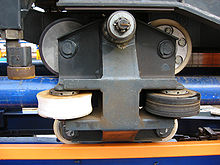
On a roller coaster train, the underfriction, up-lift, or up-stop wheels are a device to keep the train from jumping off the track under intense movement. [1] The design was patented in 1919 by John A. Miller. [2] [3]

On a roller coaster train, the underfriction, up-lift, or up-stop wheels are a device to keep the train from jumping off the track under intense movement. [1] The design was patented in 1919 by John A. Miller. [2] [3]

A roller coaster, or rollercoaster, is a type of amusement ride that employs a form of elevated railroad track designed with tight turns, steep slopes, and sometimes inversions. Passengers ride along the track in open cars, and the rides are often found in amusement parks and theme parks around the world. LaMarcus Adna Thompson obtained one of the first known patents for a roller coaster design in 1885, related to the Switchback Railway that opened a year earlier at Coney Island. The track in a coaster design does not necessarily have to be a complete circuit, as shuttle roller coasters demonstrate. Most roller coasters have multiple cars in which passengers sit and are restrained. Two or more cars hooked together are called a train. Some roller coasters, notably Wild Mouse roller coasters, run with single cars.

The generic roller coaster vertical loop, where a section of track causes the riders to complete a 360 degree turn, is the most basic of roller coaster inversions. At the top of the loop, riders are completely inverted.
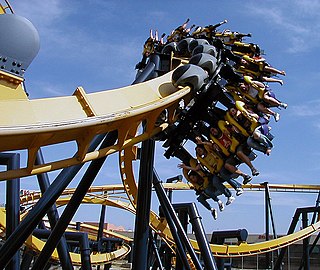
Bolliger & Mabillard, officially Bolliger & Mabillard Consulting Engineers, Inc. and often abbreviated B&M, is a roller coaster design consultancy based in Monthey, Switzerland. The company was founded in 1988 by Walter Bolliger and Claude Mabillard, both of whom had worked for Giovanola.

The Cyclone, also the Coney Island Cyclone, is a wooden roller coaster at Luna Park in Coney Island, Brooklyn, New York City. Designed by Vernon Keenan, it opened to the public on June 26, 1927. The roller coaster is on a plot of land at the intersection of Surf Avenue and West 10th Street. The Cyclone reaches a maximum speed of 60 miles per hour (97 km/h) and has a total track length of 2,640 feet (800 m), with a maximum height of 85 feet (26 m).
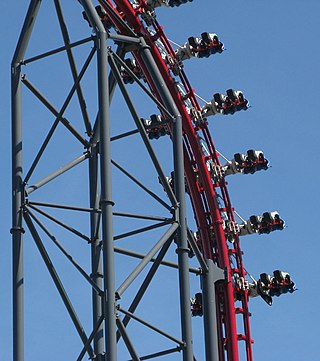
A fourth-dimension roller coaster is a type of steel roller coaster whereby riders are rotated independently of the orientation of the track, generally about a horizontal axis that is perpendicular to the track. The cars do not necessarily need to be fixed to an angle.
Harry Guy Traver was an American engineer and early roller coaster designer. As the founder of the Traver Engineering Company, Traver was responsible for the production of gentle amusement rides like the Tumble Bug and Auto Ride. His roller coasters became legendary for their unique twisted layouts and thrilling, swooped turns. At a time when most coasters were built from wood, Traver was the first coaster builder to utilize steel for the primary structural material. He also built the first motorized fire engine in New York City.

Storm Chaser is a steel roller coaster located at Kentucky Kingdom in Louisville, Kentucky, United States. Designed by Alan Schilke and manufactured by Rocky Mountain Construction (RMC) at an estimated cost of $10 million, the ride opened to the public on April 30, 2016. It features three inversions, a 78-degree drop, and a maximum speed of 52 mph (84 km/h) utilizing RMC's patented I-Box track technology.
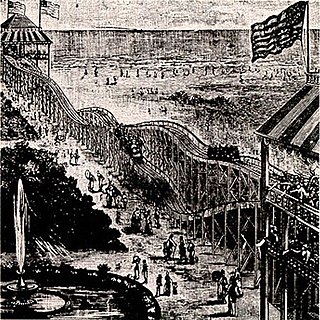
The original Switchback Railway was the first roller coaster at Coney Island in Brooklyn, New York City, and one of the earliest designed for amusement in the United States. The 1885 patent states the invention relates to the gravity double track switchback railway, which had predicated the inclined plane railway, patented in 1878 by Richard Knudsen. Coney Island's version was designed by LaMarcus Adna Thompson in 1881 and constructed in 1884. It appears Thompson based his design, at least in part, on the Mauch Chunk Switchback Railway which was a coal-mining train that had started carrying passengers as a thrill ride in 1827.

Chance Rides Manufacturing is a roller coaster and amusement ride manufacturer. The company was formed on May 16, 2002, when the former Chance Industries Inc. emerged from bankruptcy. The main office and manufacturing facility are located in Wichita, Kansas.

Shuttle Loop is a type of steel launched shuttle roller coaster designed by Reinhold Spieldiener of Intamin and manufactured by Anton Schwarzkopf. A total of 12 installations were produced between 1977 and 1982. These 12 installations have been located in a total of 22 different amusement parks.
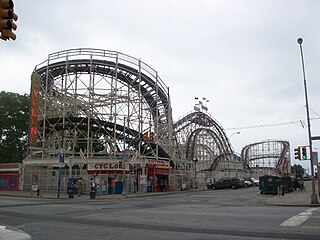
Roller coaster amusement rides have origins back to ice slides constructed in 18th-century Russia. Early technology featured sleds or wheeled carts that were sent down hills of snow reinforced by wooden supports. The technology evolved in the 19th century to feature railroad track using wheeled cars that were securely locked to the track. Newer innovations emerged in the early 20th century with side friction and underfriction technologies to allow for greater speeds and sharper turns. By the mid-to-late 20th century, these elements intensified with the introduction of steel roller coaster designs and the ability to invert riders.

Hakugei is a steel roller coaster at Nagashima Spa Land in Mie Prefecture, Japan. It was originally a wooden roller coaster known as White Cyclone manufactured by Swiss company Intamin that operated from 1994 to 2018. It was refurbished by American company Rocky Mountain Construction, which replaced the ride's wooden track with steel track and modified the ride layout, including the addition of three inversions. The renovated ride reopened on March 28, 2019.
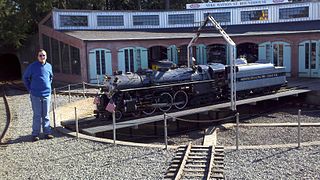
The Sonoma TrainTown Railroad is a tourist railroad and 10 acre amusement park in Sonoma, California. Its logo is based on the logo for the New York Central Railroad. Its main feature is a 15 in gauge miniature railway, which closely corresponds to a 1:4 scale model of a 4 ft 8+1⁄2 in standard gauge railroad.
Frederick A. Church (1878–1936) was an American engineer and early roller coaster designer. He is most famous for his "Bobs" series of roller coasters that featured severe banking, steep drops, and nonstop action.

Backety-Back Scenic Railway was a wooden roller coaster located at Crystal Beach Park. The ride opened to the public in 1909 and operated until 1926. The Backety-Back Scenic Railway was notable for a backward-traveling innovation which would be adopted many years later in more modern steel roller coasters. It was also one of the earliest shuttle roller coasters to be built, as well as being the second roller coaster to be built in the Crystal Beach amusement park. The coaster has been cited as a particularly beautiful example of roller coaster architecture.

Loop the Loop was a dual-tracked steel roller coaster that operated on Coney Island in Brooklyn, New York, from 1901 to 1910. The coaster was one of the first looping roller coasters in North America.

Fury 325 is a steel roller coaster located at Carowinds amusement park in Charlotte, North Carolina. Manufactured by Bolliger & Mabillard, Fury 325 opened to the public on March 28, 2015. It features a 6,602-foot-long (2,012 m) track that reaches a maximum height of 325 feet (99 m), making it the fifth-tallest roller coaster in the world and the tallest overall among roller coasters that use a traditional chain lift hill. Riders experience speeds of up to 95 miles per hour (153 km/h), winding through high-speed curves and passing over and under the park's main entrance. Fury 325 was voted the world's best steel coaster in Amusement Today's Golden Ticket Awards for four consecutive years between 2016 and 2019.

The Joker is a steel roller coaster at Six Flags Discovery Kingdom in Vallejo, California. The ride opened on May 29, 2016, as a rebuild of former wooden roller coaster Roar, adding a new steel track on top of Roar's wooden support structure. This hybrid configuration was implemented by Rocky Mountain Construction and is themed to the Joker, a comic book character villain featured in DC Comics publications. The original Roar roller coaster was constructed by Great Coasters International and opened in 1999.
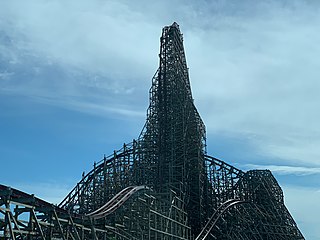
A hybrid roller coaster is a category of roller coasters that is defined as having the track made out of steel, while the support structure is made from wood. Though less common, this can also be flipped around, with the track made of wood with a steel running plate, and a support structure that is made of steel. An example of this is The Voyage at Holiday World. The wooden frame-steel track design of roller coaster is mostly known to be utilized by Rocky Mountain Construction in their I-Box track design, and Arrow Dynamic's Mine Train style roller coasters.